A glamorous tour of Grand Hotels looking at design and detail
The Grand Budapest Hotel
At the 86th Academy Awards in February this year, it came as little surprise when Adam Stockhausen was presented with the Oscar for Best Achievement in Production Design for The Grand Budapest Hotel. Stockhausen succeeded in creating an impressionistic land with flavours of Eastern Europe that on screen looked almost as if it had sprung to life from the pages of a picture story book. Who could forget the image of the lavish 19th Century hotel perched aloft on rugged, snow-capped peaks in the fictional province of Zubrowka? And who could forget the pink, funicular rail car tracking slowly up a mountain face before arriving at the summit? And on this summit…there she stands! The renowned Grand Budapest Hotel.
It’s here that we first meet the congenial concierge Monsieur Gustave and an ensemble of motley characters that begin an adventure across the Continent in pursuit of exoneration from a false accusation of murder. The direction and performances are highly memorable; nevertheless you could argue that the scene-stealer is the scenery itself. A wild, alpine landscape provides a dramatic back drop to the story as it unfolds, but it’s the presentation of the fabulously lush hotel that sends imaginations soaring back to an age of gilded grandeur for those fortunate enough to afford it.
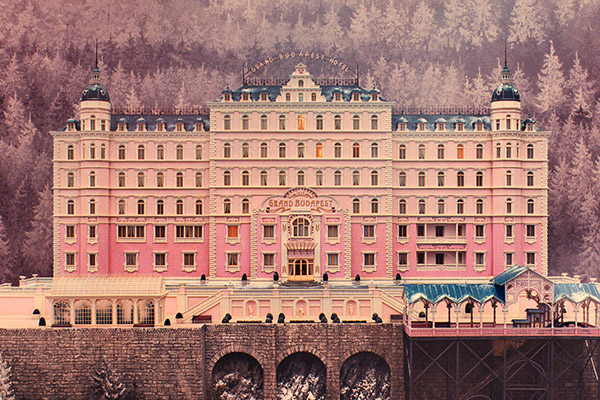
The Grand Budapest Hotel in the film by Wes Anderson
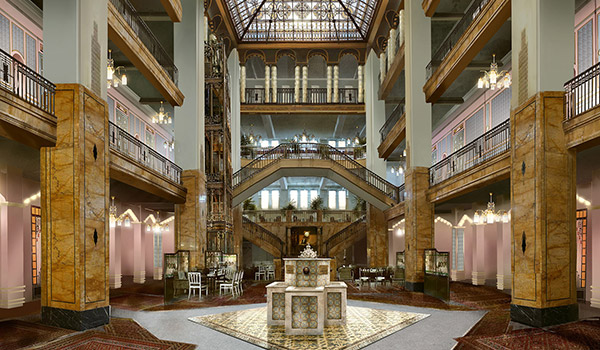
Interior of the grand entrance foyer of The Grand Budapest Hotel in the film by Wes Anderson
Grand Hotel, 1932
Wes Anderson’s portrait of the eccentric idealist Monsieure Gustave is not the first film (and surely won’t be the last) to draw inspiration from the opulent interiors of a European hotel. Edmund Goulding’s 1932 cinematic classic Grand Hotel is set almost entirely within a luxury Berlin hotel that becomes the stage – so to speak – upon which the lives of various guests play out. Some characters simply coincide in seemingly unrelated fashion, whilst the paths of others become entangled during their residency at The Grand Hotel. The film starred Greta Garbo, John Barrymore, and Joan Crawford and was a runaway hit with audiences and critics alike. Moreover, it gave rise to the ‘Grand Hotel theme,’ a term now used to describe a story set in a singular location where the activities of various characters become entwined. You could even describe in a similar vein John Cleese’s landmark comedy series Faulty Towers where the hotel is almost as significant to the piece as the characters themselves.
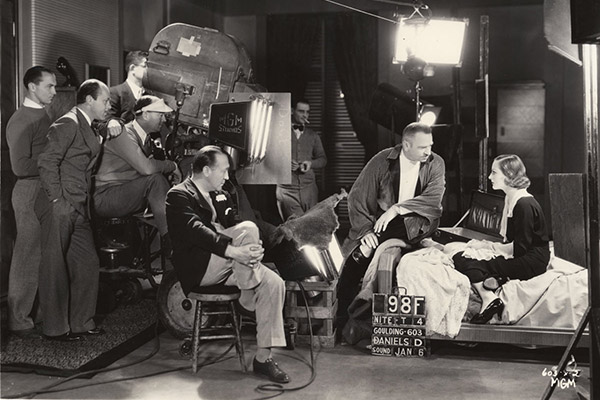
Behind the scenes during the filming of Edmund Goulding’s 1932 cinematic classic Grand Hotel
The Archetypal European Hotel
There’s no doubt about it, when it comes to interiors the French like their salons fairly sumptuous. And perhaps one of the most celebrated examples is the Hôtel du Louvre. Originally situated on the Place du Palais-Royal, the Grand Hôtel du Louvre was the first and quintessential French deluxe hotel. It opened in 1855 and received society guests until its premature closure in 1887 after a financial scandal sent the managing company into collapse. It reopened on the south side of the Rue Saint Honoré in 1888 where it stands still today.
The hotel exhibited many features that have come to be synonymous with Beaux-Arts Paris; generous proportions, gilded galleries, magnificent glass and cast iron skylights, chandeliers, return staircases, frescoes to the ceilings and walls, and decorative cast iron balustrades. In 1872 it was the largest hotel in Europe and was described in the Baedeker travel guide as ‘a huge, palatial edifice.’ The original building pioneered many innovative features, including private bathrooms and two steam-powered elevators. The ground floor that addressed the Rue de Rivoli became the Grands Magasins du Louvre, one of the original Paris department stores built to rival the newly opened Le Bon Marché. The architect was Alfred Armand, but Jacques Ignace Hittorff, Auguste Pellechet and Charles Rohault de Fleury are also attributed with the design. Hittorff in particular was noted for being experimental with new materials – particularly cast iron – and his workmanship was in demand after his commission of the impressive cast iron and glass dome of the grain market, the Halle au Blé.
Cast iron and glass
In the 1850s, architects in the US were pioneering steel construction technology with pre-fabricated cast iron and glass facades. Across the Atlantic, European builders were experimenting with the same materials to roof over vast spaces with enormous skylights. The result? Palatial iron and glass structures that became the hallmarks of industrialised Europe. Many of the most notable examples of iron and glass construction were found in railway stations; the new cathedrals of the Industrial Era. In Paris, the monumental station Gare du Nord was another example of Hittorff’s craftsmanship. Completed in 1865, it boasted an impressive glass and steel framed arch that remains today and marks the main entrance to the station. Back at the Grands Magasins du Louvre, Hittorff designed a glass roof that sprawled over the Great Silk Hall (Hall de Soieries) which soon became the ultimate destination for Paris’ fashionable milieu.
The Hôtel Vernet
Come the dawning of the 20th Century, luxury hotels had sprung up all across Europe and international tourism had escalated to unprecedented heights. A new, modern design ideology saw the use of steel construction (initially relegated to infrastructure such as rail stations and bridges) translate into the residential building vernacular. When Paris’ Hôtel Vernet was built in 1914 it exhibited all the trimmings and tailoring of a modern, industrial era grand maison. It was nowhere near as ritzy as the Hôtel du Louvre, but it demonstrated a timeless classicism and artful detailing in iron and glass. And it included a fabulous skylight over the hotel dining room in the style of the Hall Marengo at the Grands Magasins du Louvre.
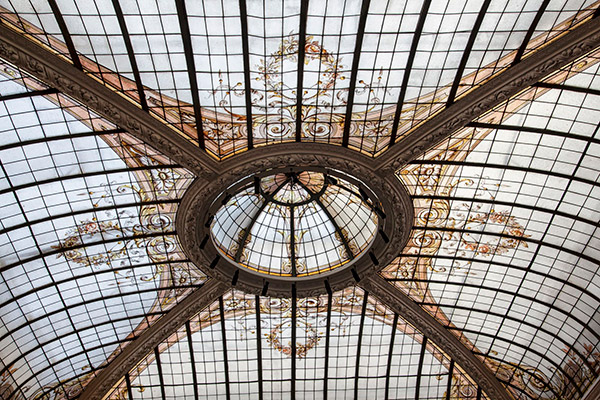
Skylight over the Hôtel Vernet dining room in the style of the Hall Marengo at the Grands Magasins de Louvre
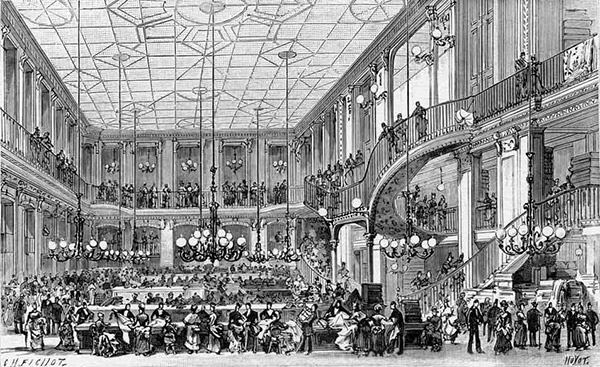
The Hall Marengo at the Grand Magasins du Louvre Engraving circa 1870
François Champsaur
To commemorate the 100 year anniversary of the Hôtel Vernet, the present owners commissioned French interior designer François Champsaur to restore the hotel to its turn-of-the-century glory with a contemporary refurbishment in 2014. Champsaur’s work at the hotel shows an indulgent delight in his use of copper and its alloys. Bronze patinated brass and patinated steel feature in his bespoke designs for furniture and light fittings. Cylindrical wall lamps in folded copper provide moments of lustre against the white plaster work. Partition screens in brass mesh frame the small entry lobby and shimmer in contrast to the fresh white walls and ceilings throughout the rest of the hotel. But perhaps my favourite detail is the copper room numbers perched on steel brackets at the entry threshold to every suite. They hark back to the lost language of Art Deco metal-smithing…and perhaps even further back to Hittorff’s early foray into decorative metals at the Grand Hôtel du Louvre.
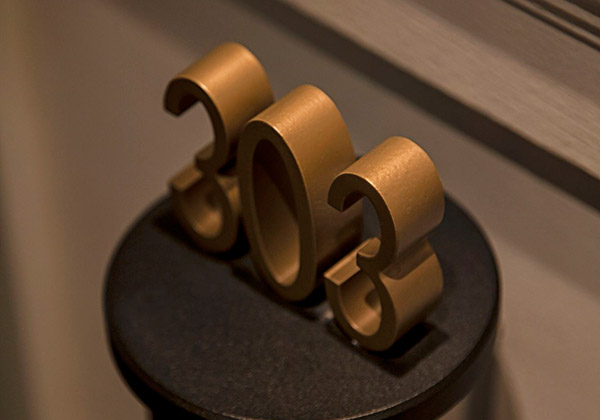
Copper room numbers on steel brackets at the Hôtel Vernet
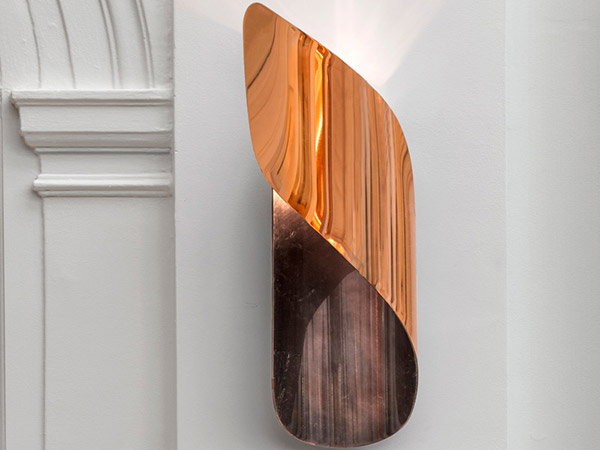
Folded copper wall lamps at the Hôtel Vernet by Françoise Champsaur
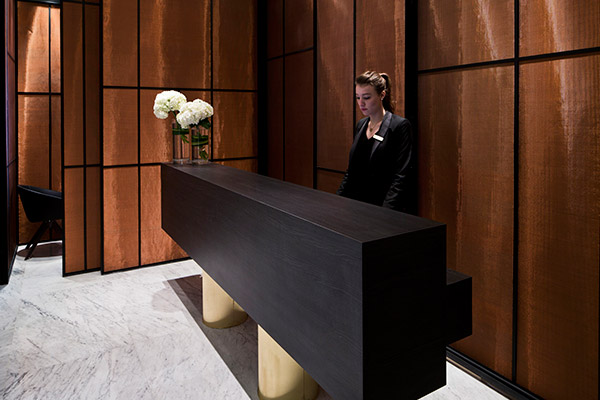
Reception desk at the Hôtel Vernet, restoration designed by François Champsaur
The Hôtel Vernet is the epitome of Parisienne le bon gout; ‘good taste.’ It presides over the Rue Vernet in all its 5-star glamour, and perfectly demonstrates a harmonious fusion of historic and contemporary design. Moreover, the refurbishment has built upon a rich legacy of luxury accommodation. Nowhere else will you find hotels built in quite the same grand tradition as in Europe… whether in Budapest, Berlin or in Paris.
…Or even on a far mountainside in Zubrowka.